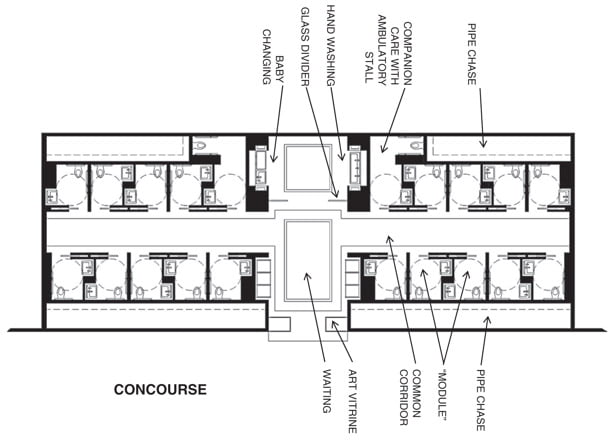Separate but Equal?
Design Considerations for Gender-Neutral Toilet Rooms in Public Schools
All across the country, school districts are trying to figure out the best ways to accommodate transgender students.
Our ongoing national discussion regarding increased access to gender-neutral public facilities has also drawn attention to a number of practical design concerns which need to be addressed in any new or soon-to-be-renovated school facility. As with most public building projects, these concerns are heavily influenced by the political, social, security, programmatic and financial requirements of their builders, as well as the design preferences of the specific communities they are to serve.
What options do schools have to address toilet rooms for transgender individuals? DRA has been thinking about this challenge for quite a while.
Security vs. Privacy
Over the past several decades, creating accessible restrooms has been an important issue which informed our thinking on this topic, particularly for existing buildings needing to be updated. Traditionally in grades 1 – 12, student toilet facilities where separated by gender, and located in multiple fixture (“gang-style”) toilets rooms located off of a corridor. This arrangement was cost-efficient for construction and allowed for a certain degree of supervision of the students by adults. These facilities had the typical toilet partition stalls with space below the doors to allow others to see if a particular stall was occupied.
When handicapped accessibility became a concern and a requirement, the economical and legal method to accommodate wheelchair users in renovation situations was to provide a single, unisex toilet room located in close proximity to the Boys and Girl’s Rooms. However, because of supervision issues, school administrators were sometimes hesitant to allow students to use a unisex/wheelchair accessible room, and would often require an aide to escort them to and from, or chose to give the disabled student a key to the room.
More enlightened designers however sought to avoid the “separate but equal” situation of unisex toilet rooms by embracing universal design concepts. This called for making every toilet room in a facility handicapped accessible, and eliminating separate unisex rooms for the disabled. However, gender separation was maintained.
In some districts another behavioral issue has surfaced with gang-style toilet rooms. If facilities are not well kept or are not well supervised, they can become prime locations for vandalism and undesirable behavior like smoking, drug usage and bullying. And a new-age problem with the proliferation of camera phones is that toilet stalls do not offer adequate privacy to users. Such behaviors can be severe enough to discourage usage by many students. In plain English, certain students may be so uncomfortable in using the only toilet room facilities available to them that they “hold-it” all day long. Such students may avoid drinking an appropriate amount of liquid. Obviously this is not an ideal educational environment.
More recently, with the concern for accommodating transgender students, many schools have begun installing more unisex single-fixture toilet rooms, particularly at the high school level.
Now as our clients have started asking DRA how to best accommodate transgender individuals and those with special needs, our thinking on this topic has attempted to meet several of these emerging requirements at the same time. These types of concerns have in turn posed additional design challenges in creating facilities that will be able to successfully adapt to changing needs and uses over the course of time.
Creating New Options
To address gender issues, we first debated whether or not another type of toilet room was even necessary. Today, we often suggest that our clients first rethink their assumptions about supervision, and determine whether or not there is an actual need to create separate facilities. Must we have “Men’s”, Women’s”, and “Other”? If using the same toilet room works at home and for disabled individuals (unisex), couldn’t this work for all students in the school as well? If “separate” equals “unequal”, should we eliminate gender-specific bathrooms altogether, and have just one type of unisex toilet room that can satisfy the needs of all? Wouldn’t this be more consistent with the goals of universal design?
Consider the example of a suburban Chicago school district, which tried unsuccessfully to accommodate a transgender student, identifying as female, who had asked to use the girls’ locker room. The school denied her request, and instead directed her to use a separate locker room that they had specifically created for transgender students. A lawsuit ensued claiming that the student was being discriminated and singled-out by using the gender neutral locker room.
Just as with handicapped accessibility, it seems a more universal design approach would eliminate the “separate but equal” standard.
Here is one possible solution:
We could eliminate gang-style toilet rooms entirely and instead install multiple separate rooms (not stalls); each with a toilet, sink and space for wheelchair accessibility. Each room would be shared by all students equally and could be labeled simply “Toilet Room”; not “Men’s”, “Women’s”, or “Gender Neutral”. This design could accommodate all students, and offers more privacy.
These rooms would be located adjacent to one another for efficiency sake and to minimize waiting time. Also, similar to airplane toilets, there could be a light or sign to indicate if each room is currently occupied or not.
To address the supervision issue, this multi-use facility can be located right off of a corridor, similar to the current location of gang-style toilets. A conspicuously located camera in that corridor could document what’s going on, and would discourage unwanted behavior.
This design solution addresses another issue too. During assembly events, such as concerts, plays and sporting events, when the demand for toilet facilities is high, women often have to wait much longer than men. If all of the toilet facilities were uniform and available to all there would be less waiting and a more efficient use of a given number of plumbing fixtures.

Universal design example Conceptual airport restroom of the future layout
(Transportation Research Board)
Obstacles to overcome
Construction costs for multiple, single-fixture toilet rooms may be in the vicinity of 10% to 15% higher than for a comparable number of plumbing fixtures in a traditional Men’s and Women’s Room arrangement. This is due to the additional doors, walls, lights, fans, and floor drains needed for each individual room.
Another concern about this design strategy is the plumbing code as currently written. Some plumbing and building inspectors interpret their local codes to allow unisex toilet rooms only for the accommodation of handicap accessibility. Otherwise all other toilet rooms must be labeled “Men” or “Women”. In these circumstances it would be difficult to implement the multiple, single fixture non-gender toilet room strategy unless the Plumbing code is updated.
Clearly there will also be a cultural shift necessary to adopt this new strategy. Many students and parents will be initially uncomfortable if we were to stop separating people and plumbing by gender. But the privacy, comfort and ultimately fair treatment of all would hopefully outweigh these reservations.
If we choose this path, it will be a challenge for us to recognize and plan for these cost issues, societal norms and space concerns.
Our laws, building codes, planning efforts, and usage patterns will all need to continue to adapt, just as our own thinking, assumptions and behaviors will need to evolve in order to deal with these challenges.

